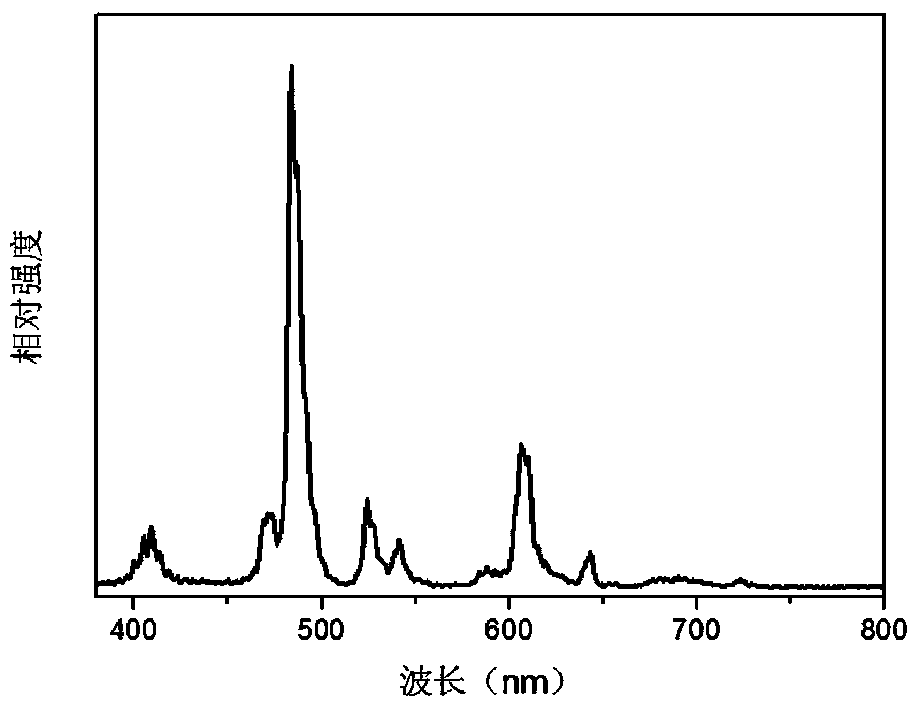A long afterglow material that can be excited by x-rays and its application
An X-ray and long afterglow technology, applied in the field of biological imaging materials, can solve problems such as poor tissue penetration, and achieve the effect of narrow emission spectrum band, wide application prospect and good photostability
- Summary
- Abstract
- Description
- Claims
- Application Information
AI Technical Summary
Problems solved by technology
Method used
Image
Examples
Embodiment 1
[0031] (1) Add 0.005mol NaNO 3、 0.00495mol Y (NO 3 ) 3、 0.00005mol Pr(NO 3 ) 3 Dissolve in 20mL of water, stir evenly to obtain aqueous solution A;
[0032] (2) Dissolve 0.005mol of EDTA-2Na in 30mL of water, stir well to obtain aqueous solution B;
[0033] (3) Add 0.02mol of NH 4 Dissolve F in 10mL of water and stir evenly to obtain aqueous solution C;
[0034] (4) Add aqueous solution B to aqueous solution A, stir for 30 minutes, then add aqueous solution C, and stir to obtain a reaction mixture;
[0035] (5) Put the reaction mixture into a high-pressure reactor, put the high-pressure reactor into a dry box and heat up to 180°C and keep it reacting for 12 hours; after the reaction is completed, let it cool naturally, centrifuge the solution, and dry it to obtain NaY 0.99 f 4 :0.01Pr 3+ Material.
Embodiment 2
[0037] (1) 0.005mol NaNO 3、 0.00495mol Gd(NO 3 ) 3、 0.00005mol Pr(NO 3 ) 3 Dissolve in 20mL of water, stir evenly to obtain aqueous solution A;
[0038] (2) Dissolve 0.005mol EDTA-2Na in 30mL of water, stir well to obtain aqueous solution B;
[0039] (3) Add 0.02mol of NH 4 Dissolve F in 10 mL of water and stir evenly to obtain aqueous solution C;
[0040] (4) Add aqueous solution B to aqueous solution A, stir for 30 minutes, then add aqueous solution C, and stir to obtain a reaction mixture;
[0041] (5) Put the reaction mixture into a high-pressure reactor, put the high-pressure reactor into a drying oven to raise the temperature to 180°C and keep the reaction for 12 hours; after the reaction is completed, cool it naturally, centrifuge the solution, and dry it to obtain NaGd 0.99 f 4 :0.01Pr 3+ Material.
Embodiment 3
[0043] (1) 0.005mol NaNO 3、 0.002475mol Y (NO 3 ) 3、 0.002475molGd(NO 3 ) 3, 0.00005mol Pr(NO 3 ) 3 Dissolve in 20mL of water, stir evenly to obtain aqueous solution A;
[0044] (2) Dissolve 0.005mol EDTA-2Na in 30mL of water, stir well to obtain aqueous solution B;
[0045] (3) Add 0.02mol of NH 4 Dissolve F in 10 mL of water and stir evenly to obtain aqueous solution C;
[0046] (4) Add aqueous solution B to aqueous solution A, stir for 30 minutes, then add aqueous solution C, and stir to obtain a reaction mixture;
[0047] (5) Put the reaction mixture into a high-pressure reactor, put the high-pressure reactor into a drying oven to raise the temperature to 180°C and keep the reaction for 12 hours; after the reaction is completed, cool it naturally, centrifuge the solution, and dry it to obtain Na(YGd) 0.99 f 4 :0.01Pr 3+ Material.
PUM
 Login to View More
Login to View More Abstract
Description
Claims
Application Information
 Login to View More
Login to View More - Generate Ideas
- Intellectual Property
- Life Sciences
- Materials
- Tech Scout
- Unparalleled Data Quality
- Higher Quality Content
- 60% Fewer Hallucinations
Browse by: Latest US Patents, China's latest patents, Technical Efficacy Thesaurus, Application Domain, Technology Topic, Popular Technical Reports.
© 2025 PatSnap. All rights reserved.Legal|Privacy policy|Modern Slavery Act Transparency Statement|Sitemap|About US| Contact US: help@patsnap.com



